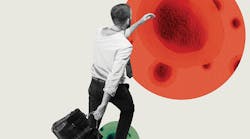Recent post-approval studies of prescription drugs seem to have brought nothing but bad news. It was just reported that Singulair may have been a contributing factor in three or four recent suicides. Now, that is 4 out of 30,000,000 prescriptions written for the product.
A rough calculation would show a 0.0000133% negative result, based on preliminary data. If only aspirin were that safe! While every side effect and certainly every death is cause for sadness, we have to look at many, many things before we panic. Consider the automobile, the use of which has not yet been banned in any state, despite the thousands of auto-related deaths and injuries that occur each year. We face risk all day, every day.
The aforementioned aspirin tablet always causes some bleeding in the stomach lining; acetaminophen can cause liver damage, especially when coupled with ethanol; various vaccines can cause symptoms of the very diseases protect us from, and the beat goes on. Are there abuses in the industry? Is the Pope Catholic? Whenever you have a business wherein billions of dollars/ Euros/yen are at stake, there will always be pressure to, if not exactly fudge clinical results, at least to understate the importance of any finding.
Can we attribute this to greed or ignorance or indifference? Maybe a little, but it is not all one-sided, after all. Our current clinical trial procedures were formulated in a time when the diseases we were treating were acute, not chronic. When we receive a polio vaccine, it is a oneor two-shot deal. Typhoid, measles, small pox, and so forth are all addressed with one injection, maybe followed by a booster sometime later. We take antibiotics for seven to fourteen days for an infection.
We were happy to know that taking multiples of the drugs did not cause more than a few (usually minor) symptoms. Then, along came The Pill, perhaps the first medicine designed to be taken by healthy people to prevent a condition. The earliest doses were many, many times more powerful than todays levels. Many of the warnings on the label are carryovers from that time. Progress was made by post-approval clinical trials and mining patient histories for data.
Over time, estrogen levels were lowered, and new and better dosage forms were approved. It became safer. Instead of saying that the industry missed the boat by making the levels so high, I would rather focus on the fact that manufacturers admitted errors and adjusted them. The reasons that initial clinical studies are not the final word are many.
One is that the participants used to be male prisoners or college students who participated because they needed the money. The majority of the new drugs were not tested on children, older people, or women of child-bearing age. On top of that, patients often do not take the drug exactly as asked. I personally know of a woman who stopped an antibiotic regimen for her children as soon as the symptoms disappeared, then administered the (saved) drugs whenever they exhibited similar symptoms later on.
This is patient behavior that is not often reported or taken into consideration when effectiveness of a product is considered. It is neither the (entire) fault of the physician nor the pharmaceutical company. While education is one answer, recent exit polls after elections show how well people understand issues that are repeated continuously; what hope can we have for a single set of instructions, issued verbally by a harried doctor or nurse?
Perhaps, were we not so litigious, we might consider all the risks involved with taking or not taking medicine. So before we, as a society, shout Get me a lawyer, then get me a doctor, perhaps we should try to decide whether problems are 1) serious enough, 2) accidental, perhaps based on insufficient time on the market, or 3) occur often enough to warrant a panic. My guess is that any chemical or food will cause problems for someone. How many people would die from the peanuts given out on an airline flight (aside from starvation)?
Should we outlaw legumes or sue peanut farmers? Lets give some thought to whether the sky is really falling before we go Chicken Little on the pharmaceutical industry.



